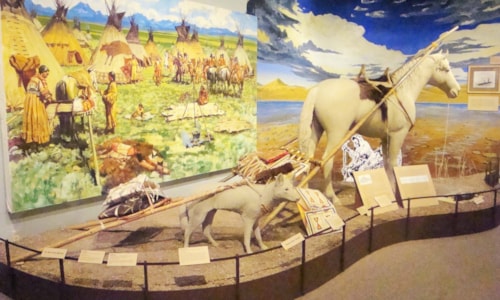The Noble Experiment
Changing Tempo
The crisp air bites the tips of your ears as you hustle down the street, wrapping your fur more tightly around yourself. The smell of cigarette smoke hits your lungs as you pass a couple men shooting the breeze outside the Montana Club, their lingering gaze sending a sharp jolt down your spine.
Clad in your favorite emerald dress and adorned with pearls you quickly trot down the stone stairs where your husband awaits, holding the door. Immediately, you are transported.
Your coat falls from your shoulders as the doorman sweeps your belonging to the rack, and your husband quickly takes your hand turning to the crowded floor. A live band is nestled in the corner of the toasty room, playing a variety of Jazz numbers as the alcohol flows. The room is alive as couples dance, and soon you too are moving across the floor as one.
It’s the roaring 20’s, and there is this nagging feeling that times are changing, that a movement is happening right below your feet … and yet you can’t shake the adrenaline rush that comes from breaking the rules.

This month, nearly 100 years after the 18th Amendment took effect, we are stepping back in time to take a look at the prohibition era in Montana. All we ask is that you take a moment to truly enter in to the story.
Prohibition Gets its Start in Montana
It was the gold rush that first drew crowds to Montana. The west beckoned exploration, and time and again miners struck it rich as they identified new and more promising lodes.
Meanwhile, the Homestead Act passed in 1862, and while today’s perspective offers the knowledge of Montana’s agricultural promise, it took years for homesteaders to decide that this promise would be enough to take a chance and move further West.
Montana saw its first homestead entry in 1868, and even then, there wasn’t a huge influx of farmers. People held back knowing that the promised 160 acres may not be enough to “make it.” In 1909 the Enlarged Homestead Act was passed, and because 1909 was a wet year, the prospects of moving to Montana seemed like a safe bet and the homesteaders started moving more readily.

Now the question is: what does the Homestead Act have to do with the temperance movement?
It was the farmers and their families (a very conservative population) that set the stage for Montana to adopt prohibition nearly two years before the 18th Amendment was ratified.
In contrast, the mining community heavily represented single men, many of which were immigrant workers, who flocked to the cities where they would often have little more to their names than a bed in a crowded public house. As we approached the 1920s, Butte was a major metropolitan area and the Anaconda Copper Company was on its way to becoming one of the largest companies in the world.

In 1916, it was becoming apparent that something needed to change. For those who supported the “dry” movement alcohol was seen as the root of society’s problems. Liquor loosened lips, encouraged rebel behavior, and would not be tolerated. Prohibition supporters cited abuse in the home, rising violence in the cities, and obscene behavior as reasons for a dry community. They offered that “if farmers went out of business, the state would go under, but if saloons went under there would be no loss in wealth.”
Those opposed to prohibition, the “wets,” felt that saloons often stood at the heart of the community. In communities like Butte, the saloons were the one place where all men were equal … Copper King or night shift miner, if you had a nickel you had a drink.
Alas, largely due to efforts by the Women’s Christian Temperance Movement and the rural citizens (farmers) a vote was passed to put prohibition in place. Montana was a bit ahead of the times, and with a successful vote in 1916, prohibition took effect in late 1918.
The 18th Amendment to the US Constitution
Following a decade long and nationwide temperance movement, the 18th amendment was ratified on January 16, 1919 and would go into effect January 17, 1920.
“After one year from the ratification of this article the manufacture, sale, or transportation of intoxicating liquors within, the importation thereof into, or the exportation thereof from the United States and all territory subject to the jurisdiction thereof for beverage purposes is hereby prohibited.”
President Herbert Hoover said of Prohibition, it is “a great social and economic experiment, noble in motive and far-reaching in purpose.” From this, prohibition came to be known as the Noble Experiment.
Plot Twist
As prohibition took effect, the people of Montana began to wonder if alcohol had simply been a scapegoat for deeper issues. Prohibition, although noble in its cause, would not last. In the 1920s the alcohol flowed; possibly more heavily than before. Bootlegging, speakeasies, and “soda shops” were popular, and the prices of the illegal substance were driven down.
At Helena’s Montana Club, millionaires would keep a cache of liquor in their designated locker. Upon their arrival to the club, an employee would go down to the Rathskeller and mix drinks using that individuals liquor stash.

It was not uncommon to find women with a private still in their homes, bootleggin’ to supplement their income.
Following an early adoption, Montana became the first state to repeal prohibition in 1926. So, what had changed since the 1916 vote in a state that had seemed so eager for change?
By the mid 1920s, farmers and ranchers had overworked the land leaving it scarred and unusable. By the late 1920s, more than 60,000 of the territory’s homesteaders had called it quits or been called to fight in the war. Remember, it was largely the farmers and rural population that had so strongly fought for prohibition.
The Anaconda Copper Company maintained its stronghold in Montana. With a large constituent, the ACC lobbied congress to repeal the enforcement of prohibition as part of the “wet” movement. Effects of prohibition included: the continued and increased consumption of alcohol; the detriment to community specifically in a lowered quality/standard of life and difficulties attracting workers, and with the passing of the 20th Amendment and the prominence of women in society.
Montana repealed the enforcement of the liquor laws with Initiative I-30 on the November 2, 1926 ballot.
21st Amendment to the US Constitution
Montana was not the only state in which prohibition was failing, and in 1933 the 21st Amendment was ratified, thus ending the Noble Experiment. The 21st Amendment to the US Constitution would repeal prohibition:
“The eighteenth article of amendment to the Constitution of the United States is hereby repealed.”
Fascinatingly, it was the passage of the 21st Amendment that truly moved society forward and allowed for the placement of regulation around alcohol.
The stories of prohibition have been passed down through the generations; while we idolize the 1920s as an era of change, it is easy to get caught up in the glitz and glam of flappers and big band jazz. Take a moment to consider what prohibition looked like for the average citizen.











